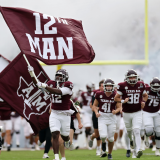Why a one-time transfer rule would be nowhere near 'free agency' for college football players
The NCAA is set to listen to recommendations from a working group on this subject in April
When the NCAA announced last month that it was seeking feedback from a working group on possibly allowing athletes in all sports to "transfer and compete immediately," the knee jerk reaction from coaches far and wide was boiled down to two words: free agency.
At best, some coaches have misinterpreted the potential impact of liberalized transfer rules. At worst, some are simply uninformed.
It wouldn't be the first time the NCAA's message got twisted. The organization sometimes makes it easy to be hard with thickly-worded press releases meant to interpret a thickly-worded NCAA Manual.
As such, just weeks ahead of the NCAA Transfer Waiver Working Group's expected recommendations in April, we are here to explain the one-time transfer rule.
CBS Sports spoke to several sources in administration, compliance and coaching to obtain a clearer picture of what could be a shift in one of college sports' traditional sources of leverage over athletes: the ability to control player movement.
The background
If the changes go through, football, men's and women's basketball, baseball and hockey would follow the same transfer rules as every other sport. Every other NCAA sport already allows a one-time transfer exception for athletes to switch schools without sitting a year in residence.
The feeling is that the current rule requiring transfers in those five sports to sit out is antiquated. Over a half-century old, it is probably subject to lawsuits in this modern age.
Don't think of this as a rule change, if it comes to pass. Think of it as massaging the transfer waiver system that has come under so much scrutiny over the last couple of years.
The basic philosophy: If players want to transfer, let them transfer.
The reaction
"In reality, I still think it's best for an athlete -- once they make their choice -- to honor their choice, to have amazing college experience. … I'm also very well aware there's tons of momentum for the one-time transfer. I think it is when not if." -- Virginia football coach Bronco Mendenhall
"Every rationale for making transferring players sit out a year has been thoroughly discredited, leaving only a few millionaire head coaches to whine about roster management." -- Tom Mars, attorney and advocate for college athletes
"I don't know how you manage a roster when this goes into effect. I can't manage our roster now. … You really have a three-year program [before going to the NFL] at a place like this." -- Alabama football coach Nick Saban
"This forces coaches to reevaluate the way they talk to players, the way they interact with players, the way they treat players. Sometimes, if you're not careful, you can become a dictator in this role. That's not good for anybody." -- SMU football coach Sonny Dykes
"Now where we're going, I think we're going to free agency. I don't think [the coaches] can win that one." -- Notre Dame basketball coach Mike Brey, president of the National Association of Basketball Coaches Board of Directors, as told to 247Sports
"I'm also open now to being more accepting of the fact that we may get to a point where football and basketball has a one-time transfer exception. It's inevitable, in my view. And so, I know that that creates mass chaos to some people, and free agency, but the reality is, the waiver process, it's a little clunky right now. And if that improves, maybe I'll feel differently. But I'm really leaning heavily to the one-time transfer." -- Ohio State athletic director Gene Smith, as told to Eleven Warriors
"We have seen kids that have entered the transfer portal and haven't been on campus for a semester. How do you learn to overcome adversity and fight through battles and learn to compete? I worry about that for our sport; I worry about that for kids and our country. The path of least resistance very rarely is the answer. How do you have discipline and structure and tough conversations in your program if there's always a Plan B, an outlet with no real repercussions?" -- Penn State football coach James Franklin, as told to ESPN
"I know, I have an idea. You recruit and develop players and when I think they're good enough I will poach them from your roster! Welcome ot what the new normal will look like in college football!" -- Ex-Georgia and Miami football coach Mark Richt, via Twitter
The reality
What the future will not be -- contrary to what some college football coaches believe -- is the absolute free flow of players from program to program. Here's why.
1. The movement of players is still somewhat restricted. Football players cannot be eligible to play football at two programs in the same season. By rule, a player can't transfer after fall camp and become immediately eligible. That's tremendously important. This is the Blake Barnett example. In 2016, the former Alabama five-star quarterback lost the starting job after a couple of series in the opener. He transferred to a junior college that season because Barnett would not have been eligible immediately in Division I. Eventually, Barnett transferred to Arizona State (2017) and South Florida (2018-19).
That transfer restriction includes schools on both the quarter and semester calendar. For discussion purposes, let's assume that semester schools start in late August or early September. Schools on the quarter system – there are at least five in the Pac-12 -- start roughly in late September. A semester athlete could not transfer to a quarter-system school and be immediately eligible. "It would preclude [playing] in that same season," one compliance expert said. "That student would not be able to compete until the following academic year."
The end of spring practice would remain one of the biggest dates on the football calendar. Position battles decided, players have to make a decision about their future. Does the transfer portal get choked with an influx of transfers with newly-found freedom?

2. These are recommended changes to existing transfer waiver rules, not a new rule. That allows the NCAA to make the change most likely in time for the 2020-21 athletic season. If the working group makes the recommendations and if they are approved, the waiver process that has become so scrutinized will become smoother. The adjustment of the waiver process would look something like this:
- The transfer cannot have faced a disciplinary suspension. Think of any player suspended for a drug positive. Clemson tight end Braden Galloway couldn't have transferred and been eligible right away after testing positive in late 2018 for ostarine, classified by the Word Anti-Doping Agent as an S1 Anabolic Agent.
- The transfer has to maintain academic progress. That progress toward a degree requirement has been around for 17 years. The "40-60-80"rules states that, prior to a third year of college enrollment, an athlete must have completed 40 percent of credit hours required toward a degree. That number goes to 60 percent before the fourth year and 80 percent before the fifth year. (Athletes must declare a major by their second year. The NCAA allows athletes five years to complete four years of eligibility.)
- The transfer has to leave school academically eligible. That's why former West Virginia safety Kenny Robinson couldn't find a home in Division I after being expelled in 2018. Robinson ended up in the XFL.
- The transfer must get a release from their departing school. This is a rule that was once in place for every college athlete, but following the creation of the transfer portal in 2018, had been removed for the five aforementioned revenue sports.
- Specific intraconference transfer rules can still apply.
The biggest hurdles are the two academic-related bullet points. Transfers making progress toward a degree may be a tough hurdle when, in general, schools don't necessarily accept all credit hours for transfers.
"It is factual that, if you transfer, you're going to lose credits," one Power Five compliance source said. "What has been lost is … when you get to that second [school], you've still got to be on pace to graduate within five years. You can't compete unless you meet academic benchmarks at the second institution."
Critics have seized upon the point regarding transfers needing a "release" from their departing school. Athletes will be allowed to transfer, but if they don't get that release, they'll have to sit out a year. There is a general feeling that, by the time a player jumps through the first three hoops, the release by a school will be a formality. If not, the coach/school will be Twitter shamed into granting a release. By then, why fight it when the downside is protracted public battle damages a program's brand?
"Kids are going to go where they want to play," said Jon Steinbrecher, MAC commissioner and chair of the working group.
The general philosophy of NCAA rule-making changed about five years ago. It went from strict adherence to the NCAA rule book to student-athlete welfare. That's what spurred the basic questions in the current name, image and likeness and transfer discussion: What's best for the athlete?
"If the student-athlete thinks it's good for them [to transfer right away], then I think that's where it's headed," Dykes said. "That's not necessarily a bad thing."
3. Sooner or later the annual limit of 25 signees in football has to be addressed. This is a somewhat easy fix. If a program is hit particularly hard, that 25 "hard cap" gets lifted. "If you had a program where there is a coaching change and 15 guys left, that's why there needs to be a flexibility on the hard cap," one athletic director said. Well, it's easy to say. But will everyone be OK with Auburn getting 35 scholarships if Gus Malzahn is let go while Alabama stays at 25 under Saban?
4. Coaches will be forced to take less chances on prospects and recruit players that best fit the program. "If players are buying into your culture, you're not going to have this mass exodus of transfers," Dykes said. "If you don't have a good culture, you're going to have a problem anyway." But that answer cannot be measured by Xs and Os in a playbook. It entails bonding, emotion and relationships. Those are intangibles that exist only in the heart and the mind.
The tampering issue may be the toughest. That's another intangible. Coaches at other programs influence players to transfer. But so do assistants, parents, friends. It might be unethical and against the rules – or not, depending on the situation.
"Most of the time a guy is in the transfer portal, it's almost too late," Dykes said. "You know about them usually because all these kids talk to each other. All these kids go through the recruiting process together. They all play 7-on-7 teams over the summer. They all have the same trainers."
And with so many players potentially entering the transfer portal, how does the NCAA begin to address the issue? So far, the coaches have not been able to police themselves.
"That's probably a question for the enforcement staff," one FBS athletic director said. "I think we know what currently goes on. But you're talking about what goes on in steroids here."
Dykes added: "At some point, you have to be ethical enough to do it the right way. At the end of the day, the NCAA is not going to anything about it, and honestly, they don't have the stomach for it."
The next steps
With the working group news coming a few days after CBS Sports reported in late January the Big Ten had proposed similar legislation, the coaching community was rightly concerned. But there is a subtle difference between the working group's task and the Big Ten's proposal. If the working group measure goes through, it would merely extend the existing transfer rules for "non-revenue" sports across the remaining five "revenue" sports.
The Big Ten proposal seeks to change the rules, basically removing the ability for a coach or school to "block" a transfer. The Big Ten's measure also means a longer, more formal process. The issue could be taken up at January's NCAA Convention with implementation in 2021 at the earliest.
Boil it down to this: With all the rhetoric, arguments and confounding press releases flying through the air, maybe it's time the NCAA and its members back away from the transfer issue.
On some level, it's supposed to be about the players deciding their careers, academics, lives and schools.
"Even debating it is sort of, 'Why are we in that business?'" one Big Ten source pondered.


















